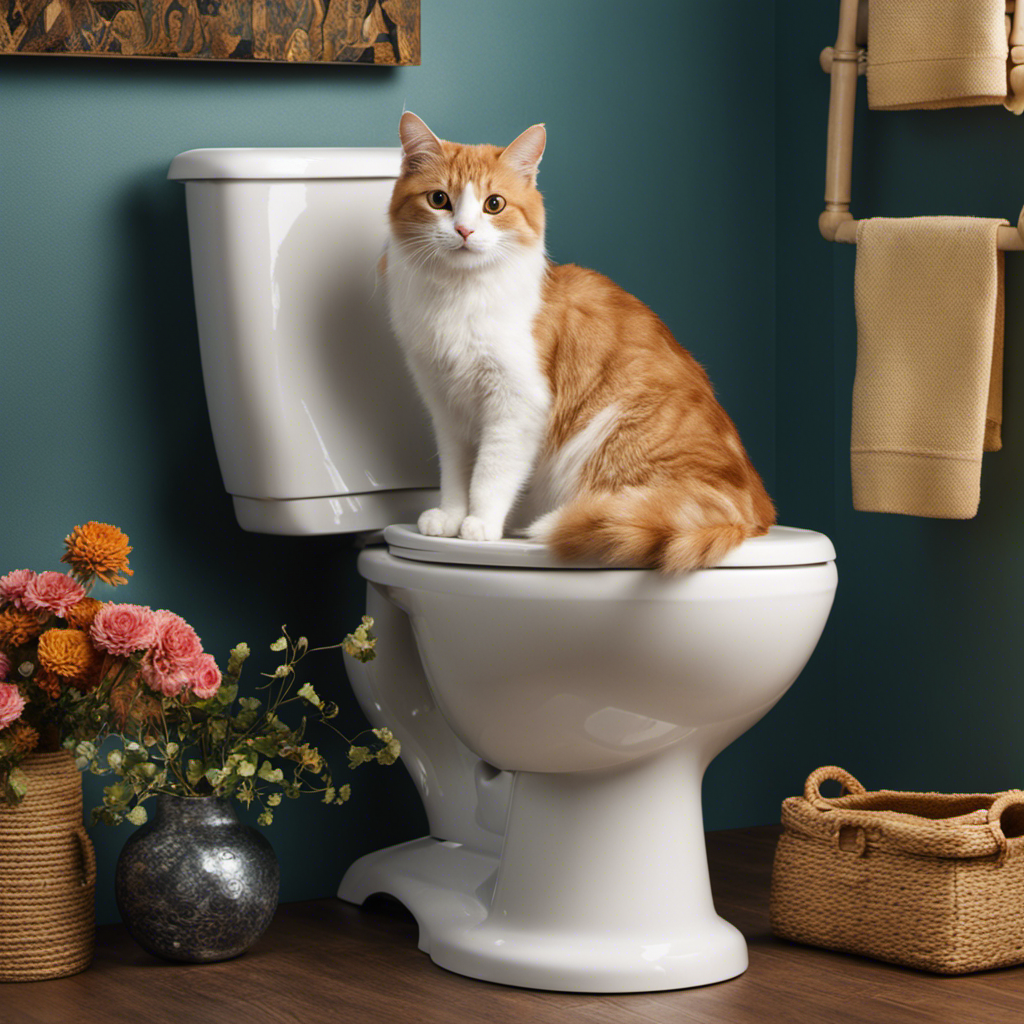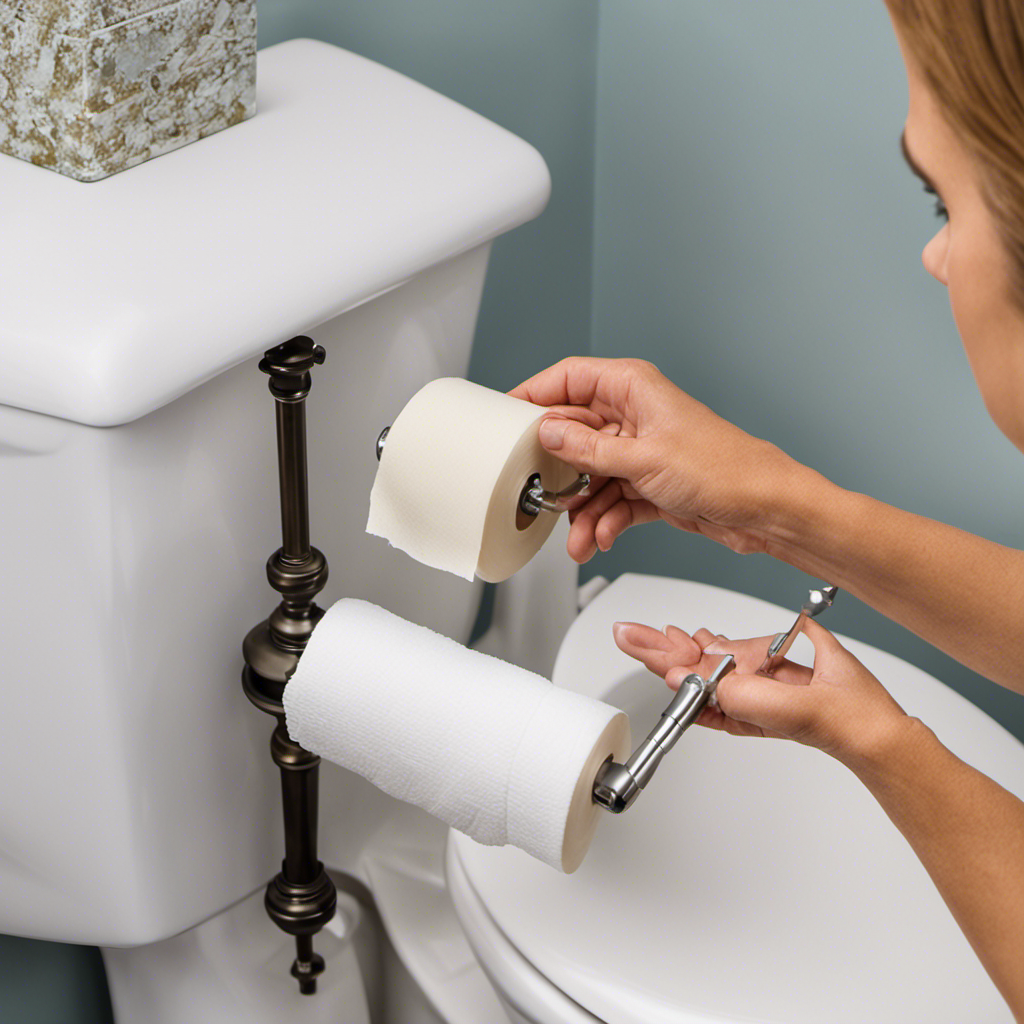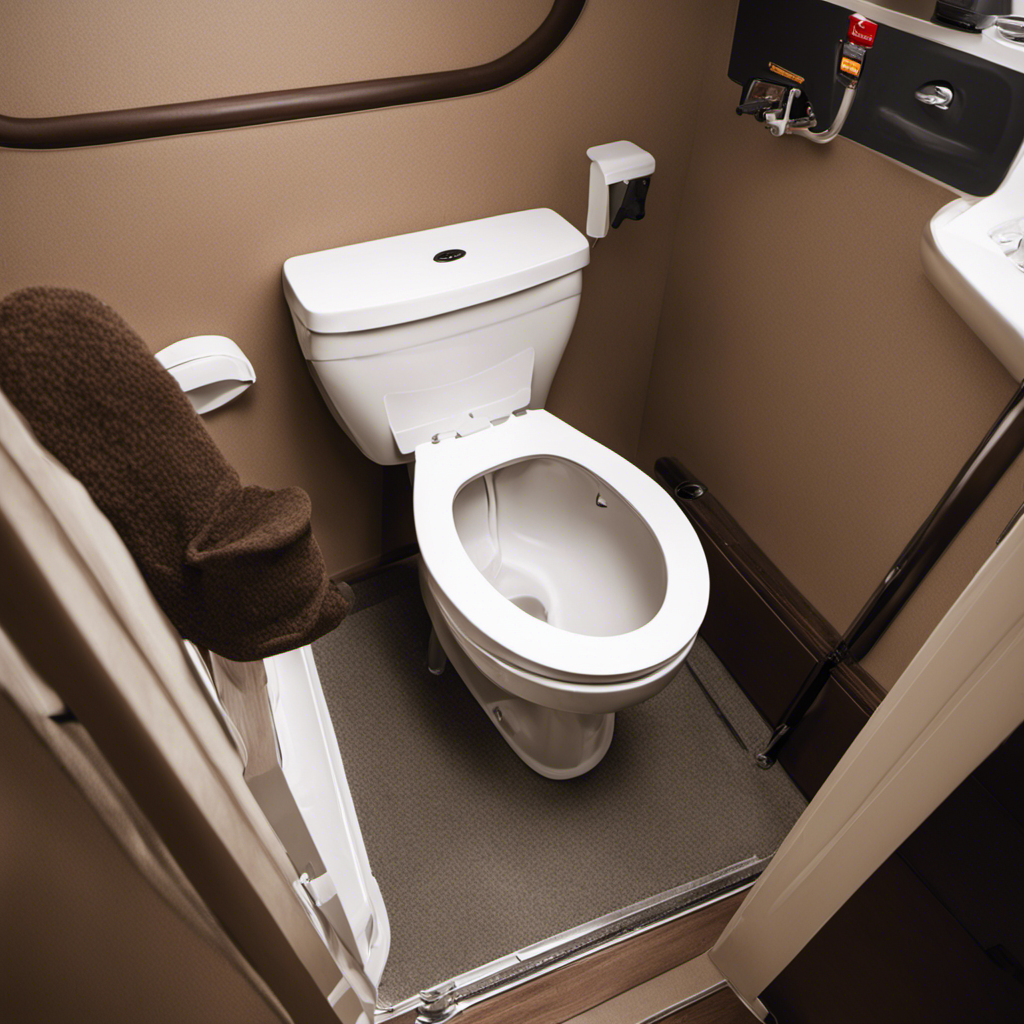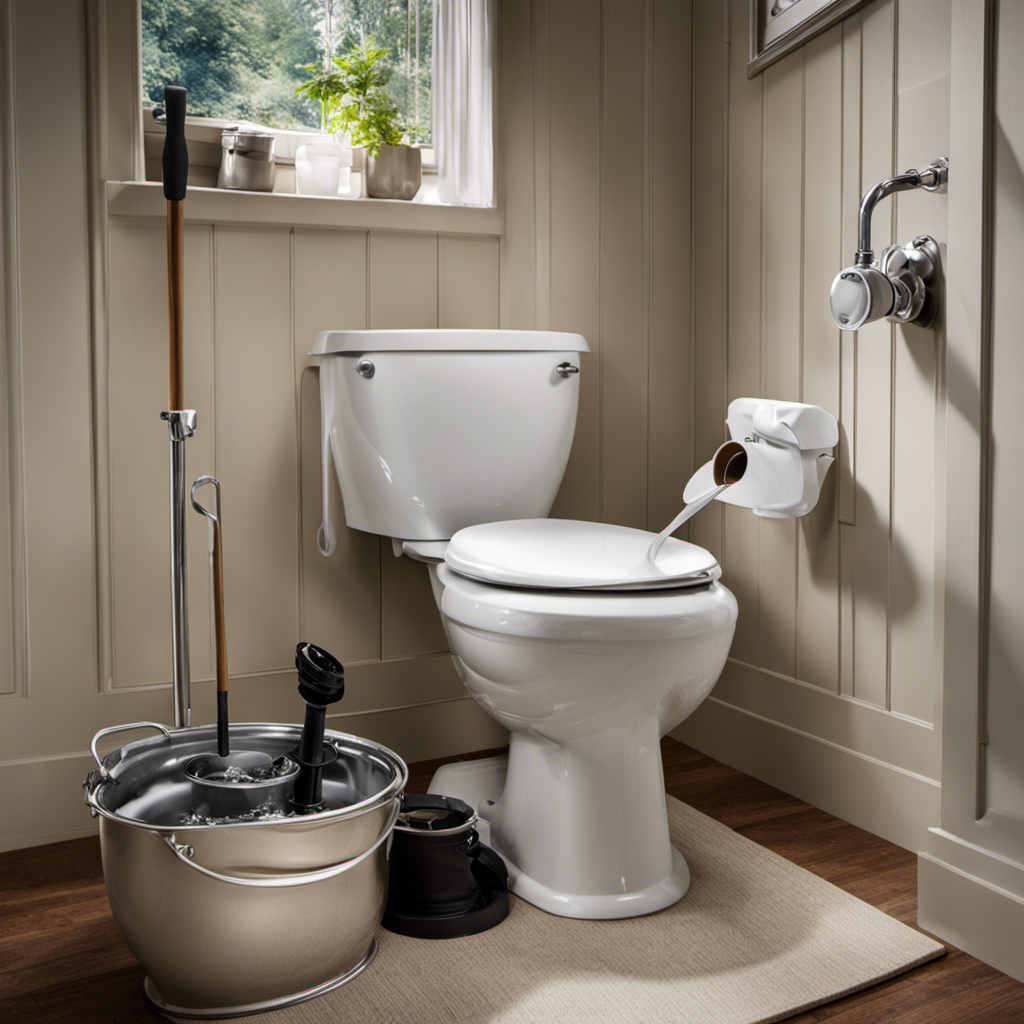I’ll show you how to teach your cat to use the toilet. Yes, you heard me right. No more litter boxes, no more mess, just a clean and convenient solution.
Imagine the freedom of not having to clean up after your feline friend. With a step-by-step guide and some patience, you can successfully train your cat to use the toilet.
So, let’s get started on this pawsitively amazing journey to a litter-free life!
Key Takeaways
- Toilet training eliminates the need for a litter box and its associated tasks.
- Understanding your cat’s bathroom habits is crucial for successful toilet training.
- Patience and rewards are essential for encouraging progress during toilet training.
- Gathering the necessary supplies and tools is important for successful toilet training.
Why Teach Your Cat to Use the Toilet
There are several reasons why you should teach your cat to use the toilet.
The benefits of toilet training your cat are numerous. First and foremost, it eliminates the need for a litter box in your home, which means no more scooping and no more unpleasant odors.
Additionally, teaching your cat to use the toilet can be a great alternative for those who have limited space or allergies to cat litter. It also saves you money in the long run, as you won’t have to constantly buy and replace litter.
Furthermore, toilet training your cat can be a fun and rewarding experience for both you and your furry friend. By understanding your cat’s bathroom habits, you can successfully guide them through the toilet training process.
Understanding Your Cat’s Bathroom Habits
Understanding your cat’s bathroom habits is crucial for effective litter box training. Feline litter box behavior can vary widely from cat to cat, but there are a few common patterns to look out for.
Feline Litter Box Behavior
To teach your cat to use the toilet, start by observing their litter box behavior closely. Cats have specific behaviors when it comes to their litter box, and understanding these behaviors is crucial for successful litter box training.
Here are four important aspects of cat behavior and litter box training techniques to consider:
-
Location: Cats prefer privacy when using the litter box. Ensure that the litter box is placed in a quiet and accessible area where your cat feels comfortable.
-
Cleanliness: Cats are clean animals and dislike using dirty litter boxes. Scoop the litter box daily and change the litter regularly to maintain cleanliness.
-
Litter preference: Cats have preferences when it comes to litter texture and scent. Experiment with different types of litter to find the one your cat prefers.
-
Multiple litter boxes: If you have multiple cats, provide each cat with their own litter box to prevent territorial issues and ensure that each cat has access to a clean litter box.
Toilet Training Techniques
Start by observing how often you notice your cat using the litter box and take note of any patterns or regularity. This will help you understand your cat’s bathroom habits and determine the best approach for toilet training.
Toilet training benefits both you and your cat in many ways. It eliminates the need for a litter box, making your home cleaner and odor-free. Additionally, it reduces the cost and environmental impact of litter.
However, it’s important to consider cat bathroom etiquette during the training process. Provide a suitable toilet training device and gradually transition your cat from the litter box to the toilet. Be patient and reward your cat’s progress with treats or praise.
Remember to maintain good hygiene by regularly cleaning the toilet and ensuring your cat has easy access to it.
Preparing Your Cat for Toilet Training
Make sure you’ve gathered all the necessary supplies before beginning toilet training with your cat. Here are some cat toilet training tips and methods to help you track your progress:
-
Litter Box: Start by shifting your cat’s litter box next to the toilet. This will help them get used to the new location and start associating it with elimination.
-
Gradual Elevation: Use a stack of books or a specially designed cat toilet training seat to gradually elevate the litter box. This will help your cat get comfortable with the height of the toilet.
-
Hole Introduction: Cut a small hole in the middle of the litter box and gradually increase its size over time. This will get your cat used to the idea of eliminating in a hole instead of on litter.
-
Remove the Litter: Once your cat is comfortable using the litter box with a hole, start reducing the amount of litter until it’s completely eliminated. This will help them transition to using the toilet directly.
Step-by-Step Guide to Toilet Training Your Cat
When it comes to toilet training your cat, there are several key points to consider.
First, you’ll need the right training materials and tools, such as a special litter box and flushable litter.
Second, it’s important to reinforce positive behavior by using rewards and praise to encourage your cat to use the toilet correctly.
Lastly, you may encounter some common challenges along the way, such as accidents or resistance from your cat.
In this discussion, I will provide detailed information and evidence-based strategies to help you navigate through these aspects of toilet training your cat.
Training Materials and Tools
Toilet training your cat requires specific tools and materials. Here are four essential items you’ll need to successfully train your cat to use the toilet:
-
Litter box insert: This is an essential tool that fits directly into your toilet bowl. It helps to gradually transition your cat from using a regular litter box to using the toilet.
-
Flushable cat litter: Using flushable cat litter is crucial for a seamless transition. It allows your cat’s waste to be easily flushed away, eliminating the need for scooping and disposing of litter.
-
Clicker: A clicker is a small device that emits a distinct sound when pressed. It is used as a training tool to mark desired behaviors and help reinforce positive behavior during the training process.
-
Treats: Positive reinforcement is key when training your cat. Use small, tasty treats as rewards for successfully using the toilet and following the training techniques.
By using these tools and materials, you’ll be well-equipped to start toilet training your cat.
Now, let’s move on to reinforcing positive behavior.
Reinforcing Positive Behavior
By providing consistent praise and rewards, I can effectively reinforce positive behavior during the toilet training process. Positive reinforcement is a powerful tool in teaching cats new behaviors.
One method that can be used is clicker training. Clicker training involves using a small device that makes a clicking sound to mark the desired behavior. When the cat exhibits the desired behavior, such as using the toilet, I immediately click the clicker and then provide a reward, such as a treat or verbal praise.
This association between the clicker sound and the reward helps the cat understand that using the toilet is the desired behavior. Over time, the cat will learn to associate using the toilet with positive reinforcement and will continue to use it consistently.
Troubleshooting Common Challenges
Now that I’ve reinforced positive behavior, let’s talk about troubleshooting common challenges that may arise during the toilet training process.
Despite our best efforts, there may be times when progress slows down or even stalls. But don’t worry, there are alternative training methods you can try!
-
Gradual Transition: If your cat is struggling with the sudden change from litter box to toilet, consider using a training seat or a litter tray that can be placed over the toilet bowl. This allows your cat to adjust gradually to the new setup.
-
Patience and Consistency: Remember that toilet training takes time and patience. Stick to a consistent routine and reward your cat’s progress. Avoid scolding or punishing them for accidents, as this can lead to setbacks.
-
Revisit the Basics: If your cat is having difficulty understanding the concept of using the toilet, go back to the basics. Start by placing their litter box near the toilet, then gradually move it closer over time.
-
Seek Professional Help: If you’re experiencing significant challenges or your cat is showing signs of stress or anxiety, it may be helpful to consult with a professional cat behaviorist or veterinarian for additional guidance and support.
Troubleshooting Common Toilet Training Issues
If your cat is having trouble using the toilet, you might want to consider adjusting the litter box placement.
Addressing anxiety and dealing with accidents are common issues when toilet training cats. Cats can be sensitive creatures, and any changes in their environment can cause anxiety and reluctance to use the toilet.
One way to address this is by gradually moving the litter box closer to the bathroom where the toilet is located. This helps the cat become familiar with the new setting and reduces their anxiety.
Additionally, accidents may occur during the transition period. It is important to remain patient and provide positive reinforcement when accidents happen outside the litter box. Clean up the mess promptly and avoid punishing your cat, as this can lead to further anxiety and setbacks in the training process.
Maintaining Your Cat’s Toilet Training Success
Maintaining your cat’s toilet training success requires consistent reinforcement and a clean litter box. Here are four important tips to help you maintain your cat’s progress and prevent accidents:
-
Stick to a Routine: Cats thrive on routine, so make sure to maintain a consistent schedule for feeding, playtime, and bathroom breaks. This will help reinforce their toilet training progress and reduce the likelihood of accidents.
-
Keep the Litter Box Clean: Cats are naturally clean animals, so a dirty litter box can deter them from using it. Scoop the litter box daily and change the litter regularly to keep it fresh and inviting.
-
Provide Multiple Litter Boxes: If you have a multi-level home or multiple cats, it’s important to have multiple litter boxes available. This ensures that your cat always has easy access to a clean and available bathroom spot.
-
Use Positive Reinforcement: Continue to reward your cat with praise, treats, or playtime every time they successfully use the toilet. Positive reinforcement will reinforce their good behavior and encourage them to continue using the toilet.
Frequently Asked Questions
What Are the Benefits of Teaching Your Cat to Use the Toilet Instead of a Litter Box?
The benefits of toilet training cats are numerous. It eliminates the need for a litter box, reduces odor and mess, and can save money on litter. Here’s how to start toilet training your cat.
How Long Does It Usually Take for a Cat to Successfully Transition From Using a Litter Box to Using the Toilet?
It usually takes a few weeks for cats to successfully transition from using a litter box to using the toilet. Some common challenges include resistance, accidents, and the need for patience and consistency.
Can All Cats Be Trained to Use the Toilet, or Are There Certain Breeds That Are More Successful at Toilet Training?
Certain cat breeds may be more successful at toilet training due to their natural intelligence and adaptability. To train your cat to use the toilet without accidents, follow a step-by-step process that involves positive reinforcement and patience.
Are There Any Health Risks or Concerns Associated With Teaching a Cat to Use the Toilet?
Teaching a cat to use the toilet may seem convenient, but there are health risks and concerns to consider. From potential urinary tract issues to changes in behavior, it’s important to prioritize your cat’s well-being when exploring new training methods.
What Should I Do if My Cat Refuses to Use the Toilet and Prefers Using the Litter Box Instead?
If my cat refuses to use the toilet and prefers the litter box, I would start by reassessing the rewards-based training approach. I would also troubleshoot common issues like litter box cleanliness and placement.
Conclusion
In conclusion, teaching your cat to use the toilet can be a rewarding and beneficial experience for both you and your feline friend. Understanding their bathroom habits and taking the necessary steps to prepare them for toilet training is crucial for success.
By following a step-by-step guide and troubleshooting any issues that may arise, you can achieve long-term toilet training success. Interestingly, a study conducted by the University of Georgia found that cats who are toilet trained have a lower incidence of urinary tract infections compared to those using litter boxes. This statistic highlights the potential health benefits of toilet training for cats.
So, why not give it a try and enjoy a cleaner and more convenient bathroom experience for your cat?










